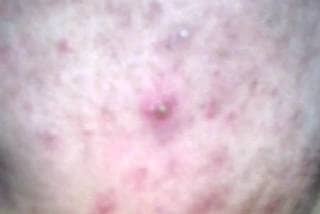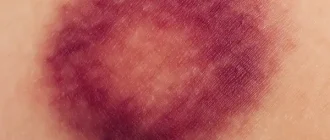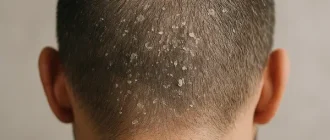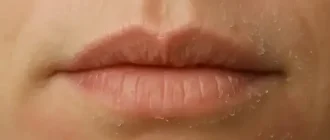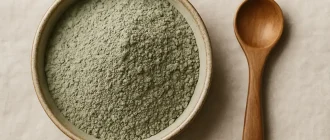Itchy skin on the outside of the nose is a surprisingly common complaint. Most of the time, it’s caused by something simple, like dryness or irritation. Still, when your nose won’t stop itching, it can feel more annoying than a mosquito bite on your elbow in July. While usually harmless, itchy nose skin can sometimes signal dermatological or behavioral conditions that deserve a closer look.This article will explain the most common causes of itchy nose skin, highlight situations that require medical attention, and outline both advanced treatments and simple skincare routines that actually help.
Common Causes of Itchy Nose Skin
This infographic highlights the most frequent reasons for itchy skin on the outside of the nose. Each bar shows the percentage of cases, with a short description below.
Dry Skin (Xerosis)
Most common reason, caused by loss of skin moisture. Usually improves with daily moisturizers and gentle skincare.
Sun Exposure / UV Irritation
Ultraviolet rays weaken skin’s barrier, making it itchy and red. Using sunscreen and protective creams helps prevent it.
Cosmetics / Harsh Cleansers
Harsh soaps strip away natural oils. Switching to mild, fragrance-free cleansers usually resolves the irritation.
Trichotillomania (Hair Pulling)
Compulsive pulling of nose hairs can cause irritation and infections. Treatment often involves behavioral therapy and topical care.
Thyroid or Skin Disorders
Conditions like hypothyroidism, eczema, or psoriasis can trigger chronic itching. Require doctor’s evaluation and specific treatment.
Source: iythealth.com
What Are the Most Common Causes of Itchy Nose Skin?
Dryness, also known as xerosis, is the number one culprit. When humidity drops, whether in Phoenix in July (low humidity, 105°F / 40°C) or during Minnesota winters, skin loses moisture quickly. This results in flaking, redness, and—you guessed it—itching.
Other causes include:
- Climate and environmental exposure: Dust, pollution, and sudden weather changes.
- Sun irritation: Ultraviolet rays damage collagen and elastin, making skin prone to dryness.
- Cosmetics and harsh cleansers: Some facial soaps strip natural oils.
- Medical conditions: Atopic dermatitis, psoriasis, thyroid disorders, and seborrheic dermatitis can all make the nose itch.
- Behavioral causes: Compulsive nose hair pulling (more on that below).
According to the American Academy of Dermatology, up to 30% of U.S. adults experience xerosis during winter months ⧉.
Could It Be Trichotillomania?
While most people occasionally trim or pluck nose hairs, some develop a compulsive urge to do so—this is known as trichotillomania. Classified in the DSM-5 as a body-focused repetitive behavior (BFRB), it involves repeated hair-pulling that relieves tension but can cause infection, irritation, or social embarrassment.
How it looks in real life: A 26-year-old man from Dallas reported frequent nose irritation and recurrent infections. He admitted to pulling nose hairs dozens of times a day, especially when stressed. Dermatologists diagnosed trichotillomania and referred him to a behavioral health specialist.
If itching outside your nose coincides with frequent hair pulling, it’s worth discussing with a doctor. Complications may include folliculitis, nasal cellulitis, and, in rare cases, infection spreading to the so-called “danger triangle of the face.”
How Do Doctors Diagnose the Cause of Nose Itching?
Modern dermatology offers several diagnostic tools:
- Clinical examination – Quick, visual inspection by a dermatologist. Accuracy: 7/10. Cost: $100–150 (€90–140).
- Patch testing – Identifies allergic triggers by applying substances to the skin. Accuracy: 8/10. Cost: $150–300 (€140–280).
- Dermoscopy – Uses a handheld scope to magnify the skin surface. Noninvasive. Accuracy: 8/10. Cost: $75–200 (€70–180).
- Lab testing – Thyroid panels or hormone tests if systemic issues suspected. Accuracy: 9/10. Cost: $150–400 (€140–360).
- AI-based digital dermoscopy – New technology analyzing skin lesions with image recognition. Accuracy: 9/10. Cost: $200–400 (€180–360).
Reyus Mammadli, medical consultant, notes that “digital dermoscopy with AI assistance is particularly useful because it reduces human error and can detect subtle skin changes earlier than traditional methods.”
What Are the Risks of Ignoring Itchy Nose Skin?
Itchy skin may seem harmless, but prolonged irritation can cause:
- Cracked skin leading to bacterial infection.
- Recurrent inflammation and scarring.
- Psychological effects, including embarrassment in social interactions.
- Increased risk of serious infection if lesions develop in the nasal area.
For example, a 42-year-old woman from Ohio ignored persistent nose irritation for months. Eventually, a small skin crack led to staphylococcal infection requiring antibiotics. Had she sought help earlier, a simple OTC cream might have prevented the escalation.
Modern Treatments: What Actually Works?
Time to See Results from Treatments
This infographic compares how long it usually takes for different treatments to improve itchy skin on the nose. Each bar shows the average time in days, scaled proportionally to the slowest option.
Barrier Creams (Vaseline, La Roche-Posay)
Work in as little as 1–3 days. They form a protective shield over the skin, locking in moisture and preventing further dryness.
Hydrocortisone Creams
Typically relieve itching within 2–3 days. These mild steroid creams calm inflammation quickly but are intended for short-term use.
OTC Moisturizers (CeraVe, Eucerin)
Show improvement in 3–7 days. These creams restore hydration to dry skin and rebuild the skin’s natural barrier.
Prescription Topicals (Protopic, Elidel)
Take about 5–10 days to calm irritation. These stronger creams adjust immune response in the skin and are prescribed by doctors.
Laser Therapy
Requires several weeks (3–5 sessions). Lasers target blood vessels and inflammation, offering results in more stubborn cases.
Gadgets & Devices (Humidifiers, LED Masks)
Take the longest—about 4–6 weeks (≈42 days). Humidifiers add moisture to air, while LED masks improve skin tone gradually.
Source: iythealth.com
Over-the-Counter (OTC) Creams and Ointments
- Brands: CeraVe Moisturizing Cream, Eucerin UreaRepair, Aquaphor Healing Ointment.
- How it works: These creams are applied 1–2 times daily, ideally after gently washing your face. Think of it like watering a thirsty plant—the skin absorbs the hydration best when slightly damp. Leave the cream on; it doesn’t need rinsing. Apply in the morning before heading out and again at night. For best results, avoid rubbing—pat gently so the cream forms a protective barrier.
- Time to effect: 3–7 days.
- Comfort: Easy to use, widely available.
- Cost: $10–25 (€9–23).
- Effectiveness: 7/10.
Topical Hydrocortisone (Low-Strength Steroids)
- Brands: Cortizone-10, Aveeno 1% Hydrocortisone Anti-Itch Cream.
- How it works: Apply a thin layer once or twice a day directly on irritated skin. It’s best used in short bursts, like a “fire extinguisher” for inflammation. Do not cover with thick bandages—it works by calming surface irritation. Many dermatologists recommend using it in the evening so the medicine has uninterrupted hours to act.
- Time to effect: 2–3 days.
- Comfort: Compact, reliable.
- Cost: $5–15 (€4.5–14).
- Effectiveness: 8/10.
Prescription Treatments
- Examples: Tacrolimus (Protopic), Pimecrolimus (Elidel), Clobetasol.
- How it works: These are usually applied once or twice daily under a doctor’s supervision. They are stronger than OTC creams and work by adjusting immune responses in the skin. Imagine them as “reset buttons” for inflammation. Because they are potent, you’ll want to wash hands before and after applying and avoid sun exposure on treated areas.
- Time to effect: 5–10 days.
- Comfort: Requires doctor supervision.
- Cost: $50–200 (€45–180).
- Effectiveness: 9/10.
Laser Therapy
- How it works: A dermatologist directs a laser beam at the inflamed or irritated zones of skin. It feels like quick rubber band snaps against the skin. Each session takes 15–30 minutes, and there’s no downtime—you can go back to work afterward. However, some mild redness may linger for a day. This option works best in cases of chronic irritation that resist creams.
- Session length: 15–30 minutes.
- Course: 3–5 treatments.
- Cost: $200–500 (€180–450) per session.
- Effectiveness: 8.5/10.
Moisturizing Devices and Gadgets
- Examples: Honeywell and Levoit humidifiers, Dr. Dennis Gross LED masks.
- How it works: Humidifiers add moisture to the air, which keeps skin from drying out—like bringing springtime air indoors during winter. LED masks use light therapy for calming irritation and boosting skin repair. Both require consistency: humidifiers should run daily in bedrooms, while LED masks need 15–20 minutes per session, several times a week.
- Time to effect: 1–2 weeks for humidifiers, 4–6 weeks for LED masks.
- Cost: $40–300 (€36–270).
- Effectiveness: 7.5/10.
Natural and Barrier-Repair Treatments
- Examples: Vaseline Petroleum Jelly, La Roche-Posay Cicaplast Baume B5.
- How it works: These act like protective shields. Apply a thin layer at night after cleansing, and let it sit as you sleep. It seals in hydration the way plastic wrap seals in food freshness. They are especially helpful during cold, windy weather when skin loses moisture fast.
- Time to effect: 1–3 days.
- Cost: $3–20 (€2.7–18).
- Effectiveness: 6.5/10.
Comparison Table: Modern Treatments for Itchy Nose Skin
| Treatment | Time to Effect | Comfort | Cost | Effectiveness (1–10) |
|---|---|---|---|---|
| OTC Creams | 3–7 days | Easy | $10–25 | 7/10 |
| Hydrocortisone | 2–3 days | High | $5–15 | 8/10 |
| Prescription Topicals | 5–10 days | Moderate | $50–200 | 9/10 |
| Laser Therapy | Weeks | Clinic-only | $200–500/session | 8.5/10 |
| Devices/Gadgets | 1–6 weeks | Home-friendly | $40–300 | 7.5/10 |
| Barrier Treatments | 1–3 days | Simple | $3–20 | 6.5/10 |
Home Care and Lifestyle Tips That Make a Difference
- Use a humidifier indoors during dry seasons.
- Wash face with mild cleansers, avoid harsh soaps.
- Limit hot showers to 10–15 minutes.
- Apply broad-spectrum sunscreen (SPF 30+) daily.
- Avoid scratching; pat skin gently with a towel after washing.
Misconceptions About Itchy Nose Skin
- “Stronger soap helps” – In reality, harsh cleansers worsen dryness ⧉.
- “It’s always allergies” – Not true; dermatologic and hormonal conditions are also common triggers ⧉.
- “Sun exposure heals dry skin” – UV rays actually accelerate skin damage ⧉.
When Should You See a Doctor?
Seek medical help if:
- Redness, cracks, or pus develop.
- OTC creams fail after 1–2 weeks.
- You experience systemic symptoms (fatigue, hair loss, weight changes).
Dermatologists can identify whether the itch is skin-deep or a sign of something more. As Reyus Mammadli emphasizes, “persistent itching is a symptom, not just an annoyance. Ignoring it may lead to larger health issues.”
Editorial Advice
Our editorial team advises readers to treat itchy nose skin seriously, not dismiss it as “just dryness.” Using brand-recognized moisturizers like CeraVe or Aquaphor is a safe first step. However, if symptoms persist, it’s wise to consult a dermatologist early.
Reyus Mammadli, medical consultant, highlights that combining medical-grade treatments with lifestyle changes (humidifiers, SPF protection, and avoiding harsh cleansers) ensures long-term relief and skin health. As he notes, “consistency beats intensity—daily small steps matter more than quick fixes.”
Effectiveness of Modern Treatments
This infographic shows how effective different treatments are for itchy skin on the nose. Scores are based on a 1–10 scale, converted into percentages for easy comparison.
OTC Creams (CeraVe, Eucerin)
Work well for mild dryness and irritation. Easy to access and use daily, but less effective for severe conditions.
Hydrocortisone Creams
Relieve itching quickly (2–3 days). Best for short-term relief, but not suitable for continuous use.
Prescription Topicals (Protopic, Elidel)
Highly effective for moderate to severe cases. Adjust immune response in the skin under medical supervision.
Laser Therapy
Targets deep irritation and blood vessels. Useful for chronic or resistant cases, though requires clinical visits.
Devices & Gadgets (Humidifiers, LED Masks)
Provide supportive care. Humidifiers add moisture to air, LED masks improve tone. Best as complementary options.
Barrier Creams (Vaseline, La Roche-Posay)
Simple and affordable. Protect the skin and lock in moisture, but usually not enough for serious inflammation.
Source: iythealth.com
About the Author
Reyus Mammadli is the author of this health blog since 2008. With a background in medical and biotechnical devices, he has over 15 years of experience working with medical literature and expert guidelines from WHO, CDC, Mayo Clinic, and others. His goal is to present clear, accurate health information for everyday readers — not as a substitute for medical advice.


